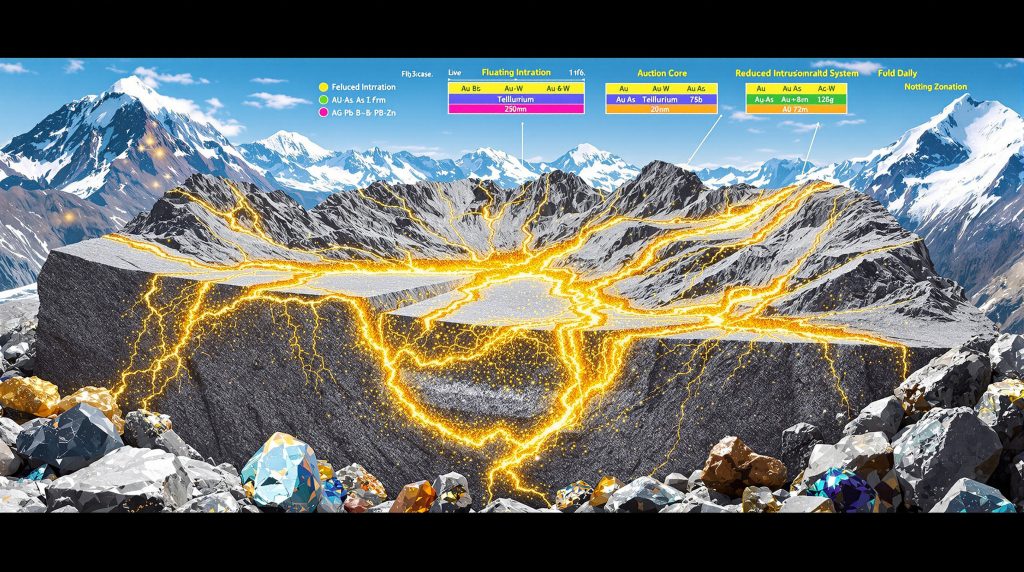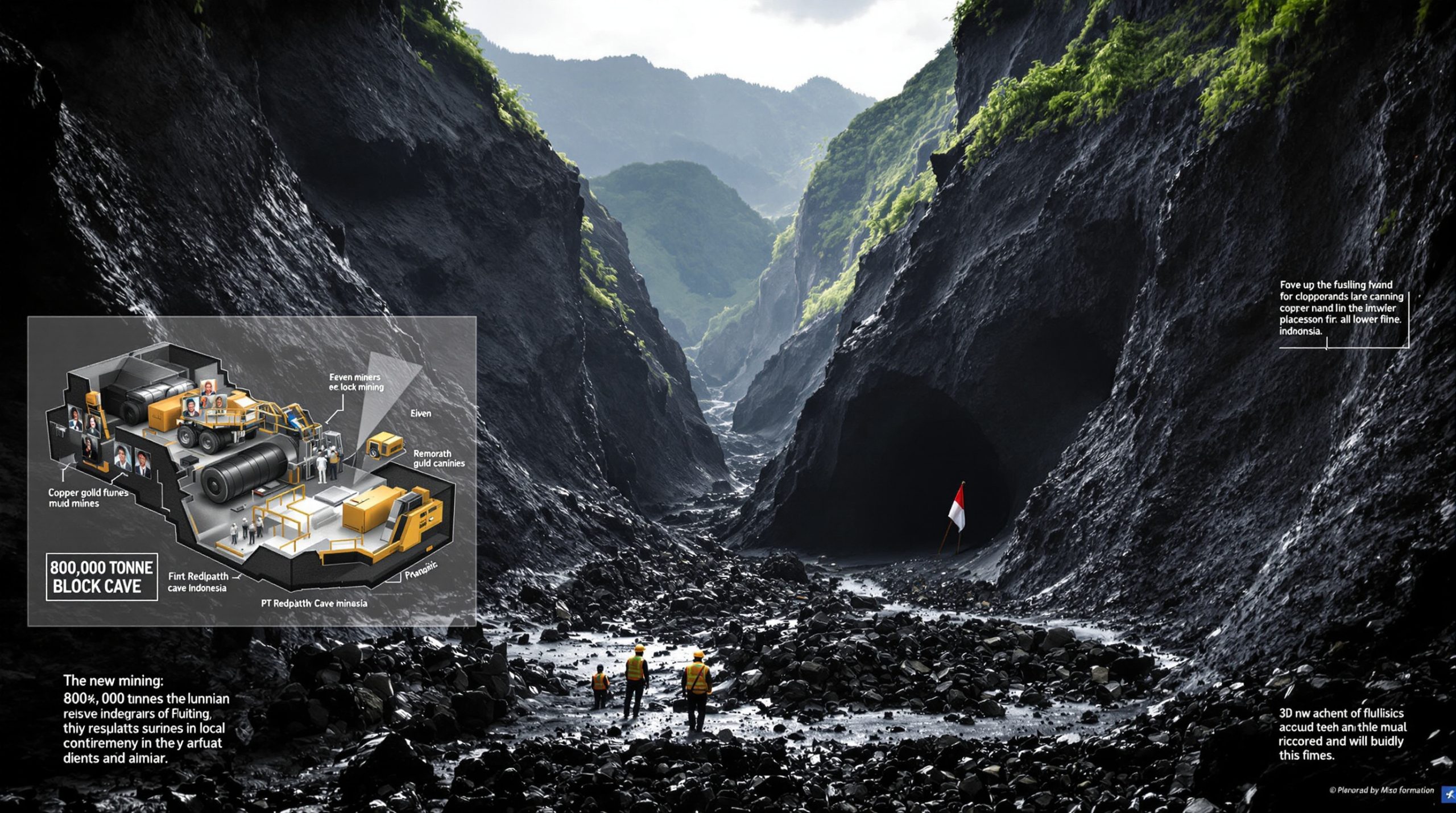What Are Reduced Intrusion-Related Gold Systems?
Reduced intrusion-related gold systems (RIRGS) represent a distinct category of gold deposits characterized by their association with moderately reduced magmatic intrusions. These systems form when magmas derived from partial melting of lower crustal rocks rise through the crust, bringing with them significant quantities of gold and other metals. The reduced nature of these magmas—meaning they contain relatively low oxygen content—creates ideal chemical conditions for gold transport and deposition.
The formation process begins deep within the Earth's crust, where melting occurs at depths of 15-40 km as crustal material descends into hotter thermal regimes. As these magmas differentiate and rise toward the surface, they form intrusive bodies that can range from small finger-like projections (apophyses) to larger plutons. The gold mineralization occurs both within these intrusions and in the surrounding country rocks, creating a complex network of mineralized zones.
What makes these systems particularly interesting to explorers is their predictable zonation patterns and characteristic metal associations. The central zones typically contain gold-bismuth-tellurium assemblages, while more distal areas may contain gold-arsenic, gold-arsenic-antimony, or even silver-lead-zinc mineralization patterns extending outward from the intrusive centers. Understanding the mineral deposit tiers is essential for effectively evaluating these systems.
Key Characteristics That Define Reduced Intrusion Gold Systems
Distinctive Geological Features
Reduced intrusion-related gold systems display several hallmark features that distinguish them from other gold deposit types. The most visible characteristic is the presence of sheeted quartz veins—thin, parallel veins that cut through the host intrusions in systematic patterns. These veins typically form when fluid pressure exceeds the confining pressure, creating fractures that fill with quartz and gold.
The intrusions themselves are typically granitic to granodioritic in composition and show evidence of a reduced state, often appearing as magnetic lows in geophysical surveys. This reduced state is crucial for gold transport, as it prevents early precipitation of gold with sulfides, allowing for more efficient concentration in favorable structural and chemical traps.
Another key feature is the spatial relationship between mineralization and intrusive bodies. Gold deposits can form within the intrusions themselves (intrusion-hosted), at the contact zones between intrusions and surrounding rocks (contact-related), or even in structures extending away from the intrusions (structure-hosted). This diversity of settings creates multiple exploration opportunities within a single system.
Distinctive Metal Associations
The geochemical signature of reduced intrusion-related gold systems provides valuable clues for exploration. The central portions of these systems typically contain gold associated with bismuth and sometimes tungsten, creating a distinctive Au-Bi-W signature. Moving outward from the intrusive center, this transitions to gold-arsenic (Au-As), then to gold-arsenic-antimony (Au-As-Sb), and finally to silver-lead-zinc (Ag-Pb-Zn) in the most distal expressions.
This systematic zonation reflects the changing chemistry of the mineralizing fluids as they move away from their source and interact with surrounding rocks. For explorers, understanding these patterns helps identify the position within a system and predict where the highest-grade mineralization might occur.
The presence of tungsten minerals like scheelite is particularly noteworthy, as it often indicates proximity to the core of the system. Similarly, bismuth minerals serve as excellent pathfinders, with their presence strongly correlating with gold mineralization in these deposits.
Structural Controls and Mineralization Styles
The structural setting plays a crucial role in the formation of reduced intrusion-related gold systems. The mineralization typically follows predictable structural patterns, with sheeted veins forming perpendicular to the direction of minimum stress. This creates systematic vein orientations that can be mapped and targeted during exploration.
Besides sheeted veins, other mineralization styles include:
-
Breccia zones – where rock fragments are cemented by mineral-bearing fluids
-
Replacement-style mineralization – where fluids alter and replace original rock minerals
-
Disseminated mineralization – where gold occurs as fine particles distributed throughout the rock
The diversity of mineralization styles contributes to the economic potential of these systems, as different styles may be amenable to different mining and processing methods. The structural complexity also creates opportunities for high-grade zones where multiple favorable factors coincide.
Where Are Reduced Intrusion Gold Systems Found Globally?
The Tintina Gold Province: Premier Example
The Tintina Gold Province, spanning from Alaska through the Yukon Territory and into northern British Columbia, represents the world's premier example of reduced intrusion-related gold systems. This vast metallogenic belt, sometimes called the Tombstone Gold Belt, hosts numerous world-class deposits including Fort Knox (Alaska), Eagle Gold (Yukon), and Brewery Creek (Yukon).
The province formed during the mid-Cretaceous period when crustal extension and thinning created conditions favorable for magma generation and emplacement. The resulting intrusions, primarily of the Tombstone and Mayo suites, created extensive contact aureoles and associated gold mineralization throughout the region.
What makes the Tintina Province particularly remarkable is the clustering of deposits, with the western cluster containing Eagle, Brewery Creek, and other deposits representing a combined resource exceeding 20 million ounces of gold. Eastern clusters continue to yield significant new discoveries, challenging earlier models that suggested decreasing gold fertility from west to east.
Other Global Occurrences
While the Tintina Gold Province represents the type locality for reduced intrusion-related gold systems, similar deposits occur worldwide:
-
Eastern Australia – The Kidston and Mt Leyshon deposits in Queensland show characteristics consistent with reduced intrusion-related systems
-
South America – Several gold districts in Brazil and other countries host intrusion-related gold mineralization
-
Siberia – The Kuranakh district contains significant intrusion-related gold deposits
-
China – Multiple provinces host gold deposits with reduced intrusion-related characteristics
These global occurrences demonstrate that the geological conditions necessary for reduced intrusion-related gold system formation have existed across multiple continents and geological time periods. However, the preservation potential and economic viability vary significantly depending on erosional history and local geological factors.
Why Are These Systems Economically Significant?
Discovery-Friendly Characteristics
Reduced intrusion-related gold systems possess several attributes that make them particularly attractive exploration targets. Their surface expressions often include visible sheeted veining and characteristic geochemical signatures that can be identified through relatively simple and cost-effective sampling methods.
This "discovery-friendly" nature means that promising targets can often be identified without extensive geophysical surveys or deep drilling programs. The presence of bismuth, tellurium, and sometimes tungsten in surface samples provides reliable pathfinders that indicate proximity to potential gold mineralization.
The systematic nature of these systems also means that once one deposit is discovered, geologists can apply predictable models to identify additional targets within the same district. This has led to the concept of "district-scale" potential, where multiple deposits may exist within a single property package.
Favorable Mining and Processing Characteristics
From an economic perspective, reduced intrusion-related gold systems offer several advantages:
-
Large tonnage potential – These systems typically contain large volumes of mineralized rock, supporting long mine lives often exceeding 20 years
-
Metallurgical simplicity – The gold is typically "free-milling," meaning it's easily recoverable through conventional processing methods without requiring complex and expensive treatment
-
Low sulfide content – The relative lack of sulfide minerals reduces environmental challenges related to acid mine drainage
-
Amenability to low-cost mining methods – Many deposits are suitable for bulk mining techniques such as open-pit operations
-
Scalability – Operations can often begin at modest production rates and scale up as infrastructure and cash flow develop
These characteristics translate into high-margin operations capable of remaining profitable across various gold price environments. The combination of large size and favorable metallurgy makes these deposits particularly attractive to major mining companies seeking tier-one assets capable of producing 400,000+ ounces annually.
Environmental Considerations
The environmental footprint of reduced intrusion-related gold systems tends to be more manageable than many other gold deposit types. Their typically low sulfide content minimizes acid generation potential, while the presence of carbonate minerals in many systems provides natural acid-neutralizing capacity.
Reclamation efforts are generally straightforward, with minimal requirements for specialized chemical treatments or long-term water management. Post-mining landscapes can often be contoured, covered with topsoil, and revegetated to create usable land with minimal long-term monitoring requirements.
This environmental profile, combined with the typically remote but accessible locations of many deposits, creates opportunities for responsible development that balances economic benefits with environmental stewardship.
How Do Explorers Target These Systems?
Geochemical Indicators and Exploration Techniques
Explorers targeting reduced intrusion-related gold systems employ a systematic approach that begins with regional-scale targeting followed by increasingly detailed work on promising areas. The initial targeting often focuses on identifying the right geological setting—areas with known reduced intrusions of appropriate age and composition.
Geochemical sampling plays a crucial role, with soil and stream sediment surveys designed to detect the characteristic metal associations of these systems. The presence of gold with elevated bismuth, tellurium, and tungsten provides a distinctive fingerprint that distinguishes these systems from other gold deposit types.
Rock sampling of outcrops, particularly those showing sheeted veining, provides direct evidence of mineralization potential. The density of veining (veins per meter) often correlates with gold grade, with some discoveries showing over 20 veins per meter in high-grade zones, providing a visual indicator of potential economic mineralization.
Geophysical Methods and Their Application
Geophysical techniques provide valuable tools for mapping reduced intrusions and associated alteration zones, even when these features aren't exposed at the surface:
-
Magnetic surveys – Reduced intrusions typically appear as magnetic lows, while surrounding hornfels zones may show magnetic highs or complex gradient patterns
-
Radiometric surveys – Can help identify potassic alteration associated with intrusions
-
Induced polarization – Useful for detecting disseminated sulfides that may accompany gold mineralization
-
Resistivity measurements – Can identify silicification associated with mineralized zones
Modern 3D geological modelling techniques allow geologists to model the subsurface geometry of intrusions and target areas where cupolas or apophyses might create favorable conditions for gold concentration.
Case Study: From Discovery to Development
The exploration journey of a typical reduced intrusion-related gold system often begins with the recognition of sheeted veining in outcrop or anomalous gold in regional geochemical surveys. Initial drilling may target areas with the highest density of surface veining or strongest geochemical anomalies.
As understanding of the system grows, exploration expands to test the three-dimensional extent of mineralization, with deeper drilling to evaluate continuity at depth and step-out drilling to define lateral extents. Metallurgical testing begins early to confirm the free-milling nature of the mineralization and establish expected recovery rates.
Economic studies progress from preliminary economic assessments through pre-feasibility and feasibility studies, with increasing levels of detail and confidence. The development timeline from discovery to production typically ranges from 5-10 years, depending on the jurisdiction, project scale, and permitting requirements.
Recent Discoveries and Emerging Trends
Notable Recent Discoveries
The past few years have witnessed remarkable exploration success in the reduced intrusion-related gold system space, particularly in the Yukon's Tombstone Gold Belt. Notable discoveries include:
-
Valley Zone – A substantial discovery featuring exceptional grades for this deposit type, with a resource estimate defining millions of ounces in a continuous near-surface deposit
-
Rackla's Grad Property – Where initial drilling has intercepted extensive zones of sheeted veining with bismuth mineralization extending over 400 meters in width
-
RC Gold Project – Where systematic exploration has identified multiple large-scale gold systems spanning over 400 meters in width
-
Flat Gold Project – Where re-evaluation of historical data combined with new drilling results interpretation has revealed multiple gold-bearing corridors
These discoveries demonstrate that significant potential remains even in relatively well-explored regions, with modern geological understanding and exploration techniques revealing systems that were overlooked by previous generations of explorers.
Technological Advancements in Exploration
Technological innovations are transforming the exploration approach for reduced intrusion-related gold systems:
-
Advanced geophysical modeling – 3D magnetic inversions provide unprecedented insights into the subsurface geometry of intrusive bodies
-
Portable XRF analysis – Allows real-time detection of pathfinder elements like bismuth and tellurium during field programs
-
Machine learning applications – Help identify subtle patterns in geochemical and geophysical data that might indicate mineralization
-
Drone-based surveys – Enable rapid collection of high-resolution imagery and geophysical data over large areas
These technologies, combined with refined geological models specific to reduced intrusion-related gold systems, have significantly increased exploration success rates and reduced the time from concept to discovery.
Future Outlook and Investment Implications
The gold industry's need for new, large-scale, high-margin deposits positions reduced intrusion-related gold systems as prime targets for both exploration companies and major producers. The combination of discovery-friendly characteristics, favorable metallurgy, and substantial size potential creates compelling investment opportunities.
For investors, companies exploring for these systems offer exposure to potential tier-one discoveries capable of attracting premium valuations. The systematic nature of these deposits also reduces exploration risk compared to more erratic deposit types, as geological models provide reliable guidance for target generation and evaluation.
Looking forward, we can expect continued exploration focus on established belts like the Tintina Gold Province, along with increased attention to similar geological settings worldwide. The transferable nature of the exploration approach means that successes in one region can inform targeting in others, potentially leading to new district-scale discoveries in previously overlooked areas.
Conclusion: The Strategic Importance of Reduced Intrusion Gold Systems
Reduced intrusion-related gold systems represent a critical component of the global gold exploration and development landscape. Their combination of large size potential, favorable metallurgy, and relatively straightforward environmental management makes them ideal candidates for the next generation of major gold mines.
For exploration companies, these systems offer attractive risk-reward profiles, with surface expressions that facilitate target identification and systematic exploration approaches that enhance discovery probabilities. For major producers, they represent opportunities to replace depleting reserves with long-life, high-margin assets capable of meaningful production contributions.
As the gold industry continues to face challenges from declining grades, increasing costs, and heightened environmental scrutiny, reduced intrusion gold systems stand out as deposits that can meet economic, technical, and sustainability requirements. Their continued exploration and development will play a crucial role in maintaining global gold supply while meeting evolving stakeholder expectations. Understanding the mineral exploration importance and implementing effective resource exploration drilling programs are key factors for successfully developing these valuable resources.
Further Exploration
Readers interested in learning more about reduced intrusion-related gold systems can also explore related educational content available on Investing News Network and review detailed research papers on Research Gate that discuss the geological characteristics and exploration potential of these fascinating gold deposits.
Looking to Capitalise on the Next Major Gold Discovery?
Discover significant ASX mineral announcements in real-time with Discovery Alert's proprietary Discovery IQ model, which transforms complex geological data into actionable investment insights. Explore why historic discoveries can generate substantial returns by visiting the dedicated discoveries page and begin your 30-day free trial today to position yourself ahead of the market.




